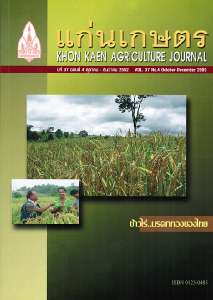Peanut production systems in a rain-fed subsistence-oriented agroecosystem in a riverine village in the Dry Zone of Myanmar
Main Article Content
บทคัดย่อ
Peanuts are the second most important crop after rice in Myanmar. They are produced mainly in the Dry Zone. Multiple cropping and double cropping are typical for the Dry Zone because single cropping is not safe for the farmers facing the meager and unreliable rainfall on limited land. This paper describes the peanut production systems in a typical riverine village in the Dry Zone. Naung Pin Win village was purposively selected as a study site and a stratified random sample of 30 households representing different types of landholding was selected. Both quantitative and qualitative data were collected, using group interviews of the village committee and farmers, semi-structured interviews, direct observation and participation. Agriculture in the village is rainfed with seasonal flooding. Only some households raise rice but all households raise peanuts in either the wet or dry seasons. Peanuts are grown as a source of cooking oil for home consumption and are the major cash crop for all households. Peanut residues are also the main feed for cattle and are a source of cash income for households that do not own large livestock. There are four different types of peanut production systems: 1) Rainy season peanuts in the dryland, 2) Dry season peanuts in the dryland, 3) Dry season peanuts after rice in the wetland, 4) Dry season peanuts in the alluvial land. Each system has different cultivation practices, requires different inputs, and provides different benefits. Dry season production on alluvial lands gives the highest yields at the lowest input cost and plays an especially important role in the livelihoods of landless households.


